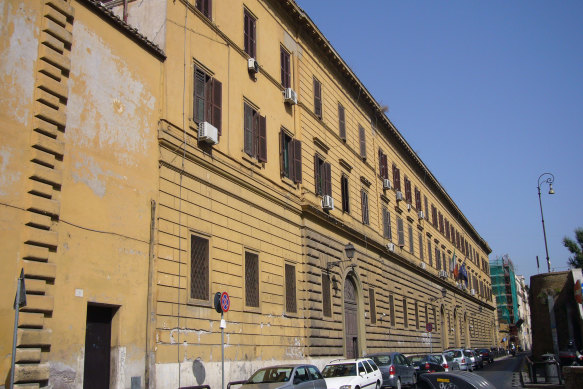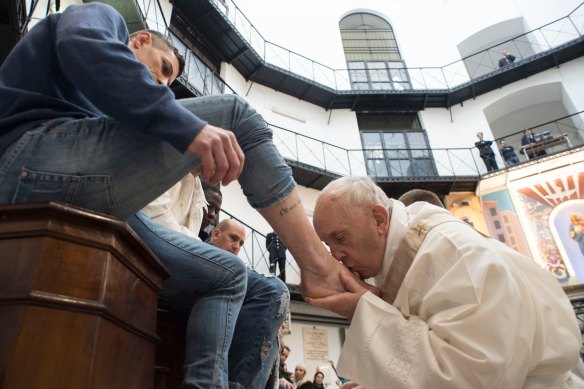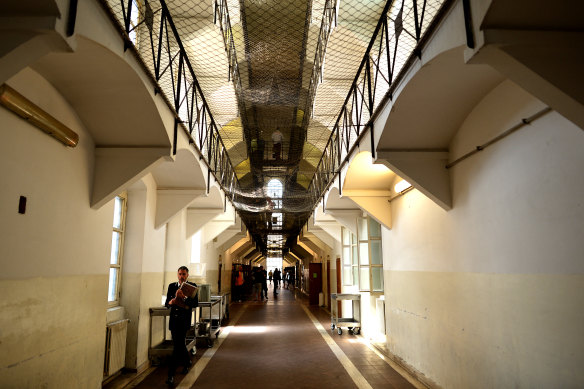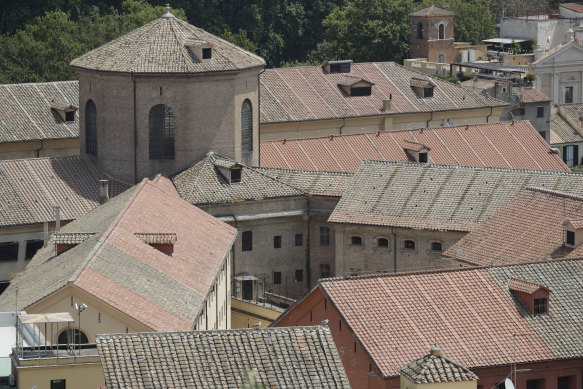This was published 6 months ago
Riots, suffering, death: The notorious Rome prison housing Easey Street suspect
By Rob Harris and Josephine McKenna
Rome: Perry Kouroumblis, the prime suspect in Melbourne’s Easey Street murders, faces weeks – if not months – in one of Italy’s most overcrowded and violent prisons, as authorities fight to bring him to Australia.
Inmates at Regina Coeli rioted just last month against conditions in the city’s oldest prison, which opened in a converted 17th-century monastery in 1881.

Regina Coeli is the central and most famous prison in the Italian capital.
The prison – squeezed among the narrow streets of Rome’s Trastevere nightlife district, a stone’s throw from the Vatican – houses more than 1100 inmates from more than 60 nationalities, who are crammed into cells of up to five men. The jail’s working capacity is just 650.
Last month’s riots took place during a sustained period of 35-degree days but Regina Coeli has no air-conditioning, green areas or recreational spaces, and many cells are without showers.
With reports of days without running water and rats spreading in the cells, up to 80 inmates set fire to furniture and destroyed surveillance cameras. Dozens also attacked prison staff, some of whom required hospital treatment.
Leo Beneduci from Osapp, the prison police officers’ union, said while inmates were concerned about the jail’s conditions, internal power struggles among the various ethnic groups had also played a role.

Pope Francis washes the feet of an inmate at the Regina Coeli prison in 2018.Credit: AP
Kouroumblis spent the first of what are expected to be many nights there after Italian state police Polizia di Stato arrested him at the capital’s Fiumicino Airport under an Interpol red notice last week. Kouroumblis, a 65-year-old dual citizen of Australia and Greece, had arrived on a flight from Athens.
He is wanted over the deaths of Suzanne Armstrong and Susan Bartlett, who were stabbed to death in a house in Collingwood in 1977. Victorian authorities will have to make a formal extradition request to Italian judicial authorities. He moved to Greece in 2017.
No charges have been laid and, if they are, they will need to be proven in an Australian court.
“This will not be a very fast process, we are not talking days,” a spokesman for Italian police said. One Australian diplomat predicted “this could be months away”, with no guarantees for the approval of the extradition request.

A guard walks down a corridor of Regina Coeli prison in Rome.Credit: AFP
Regina Coeli, with cells on upper floors opening onto walkways that overlook an open atrium below, is steeped in local folklore – it’s said you are not a real Roman until you have been a “guest” there. It sits directly below Janiculum Hill where, at dusk on Sunday, you could almost see into the cells where lights were switched on.
It was at this makeshift lookout where, until recently, prisoners were given a couple of 10-minute phone calls a week and access to emails. Relatives and loved ones also used to gather regularly to announce births, deaths and give moral support to inmates.
Inside, many religious artworks and monuments remain from its time as a monastery. One wing has hosted so many famous prisoners that it even has a preservation order.
Behind the high walls covered in cracks and flaking plaster, Italian communist Antonio Gramsci was jailed by Benito Mussolini in the 1920s. In 1943, the Nazis – led by SS commander Erich Priebke – rounded up and imprisoned more than 1000 Roman Jews. Many met a horrific death in the notorious Ardeatine massacre.

A view from the above of the Regina Coeli prison.Credit: AP
Sandro Pertini, then a relatively unknown partisan but later a president of Italy, was also sent here in 1944 by the Germans occupying Rome.
Under pressure to address the growing number of murders, rapes and drug trafficking operations behind the prison walls, the Italian parliament in August passed a law to improve conditions for 61,000 people incarcerated in the country’s prisons – about 10,000 more than the official capacity.
Chronic overcrowding and understaffing have combined with stifling summer heat to create prison conditions in which 65 inmates have taken their own lives so far this year, with two recent suicides on Wednesday, compared with 70 in the whole of 2023. It is estimated up to 10 officers also took their own lives this year.
The government has vowed to hire more prison personnel, allow inmates to make more phone calls, simplify procedures for them to obtain early release, and boost community care facilities once they are outside.
Patrizio Gonnella, the president of the prisoner aid organisation, says the situation is a “time of tension, suffering and death”.
“A prison where the number of inmates is higher than the number of regular places is a prison where life is bad,” she says.
If you or anyone you know needs help, call Lifeline on 13 11 14 or Beyond Blue on 1300 22 4636.
Get a note directly from our foreign correspondents on what’s making headlines around the world. Sign up for the weekly What in the World newsletter here.